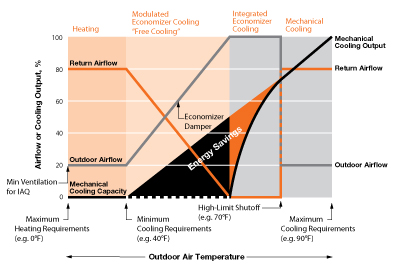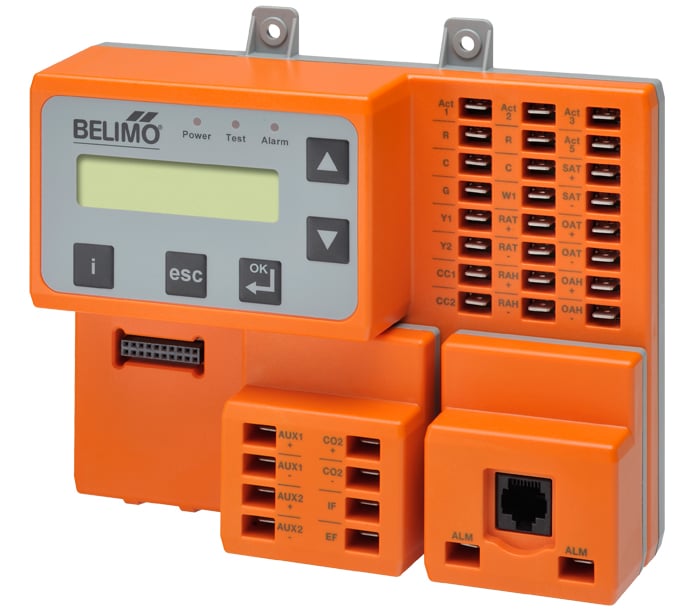Fast Route to Reliable Energy Savings
Airside economizing shouldn’t just be good in theory.
It should deliver what owners expect. With the ZIP Economizer, it does. Airside economizing isn’t just a great way to reduce operating costs; it is a requirement in most non-residential HVAC systems throughout the United States. Airside economizers also fulfill another important requirement for buildings by providing the correct ratio of outside air and return air to deliver proper indoor air quality (IAQ) to meet codes.
Unfortunately, having an economizer system doesn’t necessarily mean you are accomplishing these goals. Studies* have shown that up to 70% of economizers are not functioning properly. Many times economizer systems are set up incorrectly or are simply left to operate in factory default mode. Even worse, because economizer failures generally do not result in comfort problems many failures go undetected! These problems persist, year after year, costing building owners unnecessary expense.** Meanwhile, energy standards and building IAQ requirements are not being met.
Why does this happen? Because most economizers incorporate factory settings and confusing manuals that makes setting up, operating, and troubleshooting difficult.
Until now, economizing solutions have left a lot of room for error. The new ZIP Economizer offered by BELIMO gets efficiency strategies back on track with easy setup, automatic code change over temperatures, and superior troubleshooting capability. Users know instantly when failures occur and the ZIP helps them quickly pinpoint the problem and address it. With the following features, the ZIP leaves nothing to chance:
Easy-to-read Automotive Grade LCD Display: Extremely simple to navigate, this display delivers clear live status information, easy setup, changes, and operating history.
ZIP Code Patented Technology: By simply entering your US zip code, or Canadian postal code, the system will automatically recognize your climate zone and will set the high limit change over temperature providing automatic compliance.
Plug and Play: With its self-configuration, if it’s not plugged into the economizer, you won’t have to worry about setting it up.
Acceptance Tests: Integrated onboard test sequence that ensures effortless compliance with California Title 24, and verification of proper operation.
Fault Detection and Diagnostics (FDD): Troubleshoot faults, initiates alarms, and reconfigures for best operation.
Onboard Information: First and only economizer control that integrates onboard help for setup or troubleshooting.
Modular Design: Flexible design capable of adding remote communication and or energy savings strategies on the same footprint.
It is an established fact airside economizing (using outdoor air as a cooling medium when  conditions are suitable) is one of the smartest ways for buildings to save energy. But setting up controls to match the specific climate profiles and code requirements of different regions usually involves a cumbersome set of tasks.
conditions are suitable) is one of the smartest ways for buildings to save energy. But setting up controls to match the specific climate profiles and code requirements of different regions usually involves a cumbersome set of tasks.
The ZIP Economizer makes it easy. With an already built in all the relevant climate zone and energy code data, so simply by entering in your ZIP code you automatically maximize energy savings for your location! The ZIP code entry also automatically sets up economizer operation for compliance with all of the following codes and standards. You don't need to look up a thing!
- ASHRAE 90.1 - Energy Standard for Buildings Except Low-Rise Residential Buildings
- IECC – International Energy Conservation Code
- California Title 24 – California Building Energy Efficiency Standard
- NECB – National Energy Code of Canada for Buildings
The ZIP Economizer succeeds where others fail because it fully integrates economizing experience with local codes. Take Advantage of Utility Rebates. Not only does the ZIP ensure a maximum return on airside economizing. Many utilities will also help pay to install them. Visit www.ZIPeconomizer.com to learn more about rebate programs and energy savings opportunities.
*The Consortium for Energy Efficiency documented in 2002, that approximately 75% of rooftop units suffer from economizer malfunction, which resulted in energy use higher than without an economizer. An independent researcher in 2002, found that 70% of rooftop units in California had broken economizers (Jacobs 2002).
**The California Energy Commission reported that 64% of economizers had problems, ranging from low changeover temperature set point to failed sensors.

